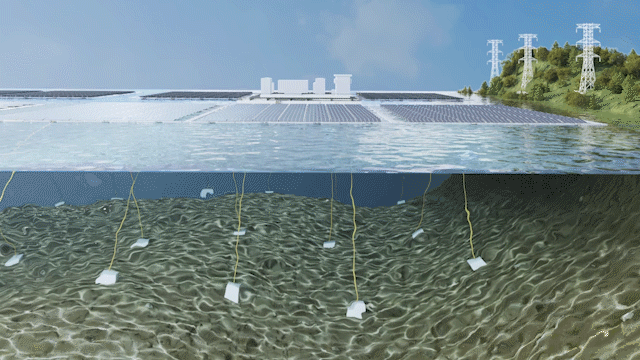The anchoring system of a floating PV station is a challenging aspect in its design and plays a critical factor for the safe and stable operation of the FPV station. It is used to secure the floating array, cope with fluctuations in water levels, withstand strong winds, waves, and water currents, control the displacement range of the floating array, and ensure the stable and reliable operation of the FPV station on the water. Sungrow FPV With extensive experience in the Floating PV Project, based on theoretical and empirical research, Sungrow FPV has applied for and obtained a series of patents related to anchoring technology. The cutting-edge technology brings a sense of security to the FPV station.
An improperly designed anchoring system, lacking comprehensive considerations, may lead to irreparable losses to clients when extreme weather conditions occur. Faced with strong winds and waves, Sungrow FPV through tailored and scientifically designed anchoring systems, enhances the system's ability to withstand wind and waves, thereby improving its resistance to overturning and pulling forces.

Some projects have a complex underwater environment with a large slope, and the conventional anchor block is easy to slip. Sungrow FPV has developed a high bearing capacity anchor block to enhance the anti-slip capacity of the anchor block by combining the research on ground investigation and geotechnics, to control the boundary of the slip, and to guarantee the stable operation of the anchoring system.

The water level variation and the difference in elevation under the water will lead to stress concentration in the floating array and large amount of drift, etc. Sungrow FPV has a professional anchoring research team, which determines the relevant coefficients of action through the calculation of wind and wave currents, hydrodynamic experiments, and a large number of wind tunnel experiments, and then conducts the modeling of floating arrays and the coupling analysis through the technical analysis software and carries out the optimal design of the anchoring system based on the results of the coupling analysis to check the force of the each anchor rope and the drift of the every floating array will be calibrated to ensure that when the water level rises and falls, the anchor ropes produce mooring effect and effectively control the drift of the array.

Recently, Cirata 192MWp floating photovoltaic power plant in Indonesia has realized full-capacity grid connection. As the first project with the hundred-meter water depth, with a water depth of 100m, a water level variation of 18m, and a difference of 50m in the underwater elevation, made this project with great difficulty in anchoring design, Sungrow FPV has completed the whole set of anchoring design of the whole project in the time requested by the client.

As each project has its uniqueness and specificity, Sungrow FPV's professional anchoring design team will take into account key environmental factors such as local wind and wave current loads, water depth and drop, water scale, topography and geological parameters, etc., and provide suitable anchoring solutions according to local conditions to provide high-quality services and help customers' value enhancement!
































